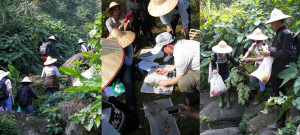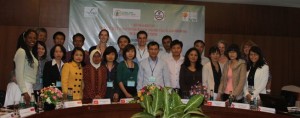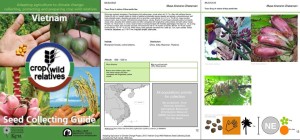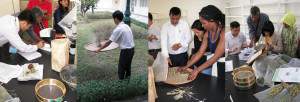Category : News
Published : February 17, 2014 - 2:28 PM
Elinor Breman, Species Collections Support Officer at Kews Millennium Seed Bank (MSB), reports on a training workshop that brought partners from across Asia together to learn about collecting, handling and banking the seeds of their crop wild relatives.
Global food security
Global food security is of growing concern in light of population expansion and climate change predictions. There are around 7,000 plant species used as food crops globally, but only 12 of these account for roughly 80% of global consumption.
Conserving the genetic diversity of the most important food plants is vital for breeding crop plants that are able to face future environmental challenges. The Millennium Seed Bank of the Royal Botanic Gardens, Kew and the Global Crop Diversity Trust have joined forces in a project to collect, conserve and make available for use the genetic diversity in the wild species related to major food crops.
This project Adapting Agriculture to Climate Change: Collecting, Protecting and Preparing Crop Wild Relatives (CWR Project) supports national institutes around the world in collecting and safeguarding priority crop wild relatives. Seed Collecting Guides have been developed to provide collectors in the field with as much information as possible about these wild plants, so that they are able to find them and collect their seeds. The Vietnam Seed Collecting Guide contains information for 17 different Crop Wild Relatives, including distant cousins of banana, apple, pigeonpea, aubergine, rice and sweet potato. The collecting guide contains a description of what the target plants look like, when they are going to have ripe seeds, where they are found, and also has some photos to help identification.
Vietnam Seed Collecting Guide: page for banana relative Musa itinerans.
This wild relative of banana is found in evergreen forests and ravines. Unlike cultivated bananas, it has large seeds (up to 7mm) and the skin of the fruit is pink rather than yellow.
Training in Vietnam
Members of RGB Kews Seed Conservation Department together with representatives of the Global Crop Diversity Trust headed to Hanoi in Vietnam to lead a training course for delegates from Indonesia, Malaysia, Nepal and Vietnam.
The week-long training course on collecting, handling and long-term conservation of seeds of wild species related to crops was hosted by the Vietnamese Plant Resources Center and funded through the Sfumato Foundation. It provided a thoroughly enjoyable and educational introduction to the world of wild species seed conservation, highlighting the particular challenges that wild species pose, compared to crops, but also how crop and wild species conservation can learn from each other.
In the lecture room, the science behind long-term seed conservation was explained, enabling participants to understand how factors such as temperature, seed moisture and seed development would affect the longevity of seeds in storage. Fieldwork planning was outlined, detailing how to target species and areas for collection, the genetic basis of sampling strategies, and how to use Seed Collecting Guides.
In the field
We then moved from the lecture room to the field to put the theory into practice. In the Ba Vi Mountains National Park, to the west of Hanoi, participants were able to
assess the quality of potential seed collections
choose appropriate sampling strategies
make collections of seeds, herbarium specimens and associated data
choose appropriate post-harvest seed handling methods

Putting theory into practice fieldwork in the Ba Vi Mountains National Park: negotiating the terrain; making a herbarium voucher; collecting target species.
The many challenges facing seed collectors in the field soon became apparent. Finding a target species when it was growing in inhospitable terrain or widely dispersed is not always that easy. When you have found it, a plant may have many fruits on it, but how many seeds are in that fruit, and how many of those seeds are fully developed and likely to germinate? The importance of checking seed viability using a seed cut test was demonstrated, together with seed number calculations which determine whether an adequate sample can be collected from the target population without impacting on the wild populations survival.
The practical session continued the following day when the material collected in the field was cleaned and counted at the Plant Resources Center. Here a variety of species requiring different cleaning techniques were used, and different winnowing methods were shared by participants.
Local culture
Whilst in Vietnam our hosts from the Plant Resources Center ensured that the course ran smoothly, that everyone was looked after and that we sampled Vietnamese culture. This included introducing participants to the wonders of Vietnamese cuisine and the organisation of an optional excursion after the course had finished to the World Heritage site, Halong Bay. Meal times and the excursion proved an invaluable time for networking among participants. At the end of the week, they left not only with their newly-acquired knowledge of seed collecting, handling and long-term conservation for wild species, but also with new friendships and an air of excitement about participating in the Crop Wild Relatives Project.

Participants and trainers on the training course, Hanoi, Vietnam (Photo: Plant Resources Center, Vietnam)


